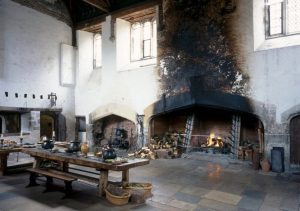Living History: Museum Space and Active Sites
Every January, the first-year fellows of the Winterthur Program and several students in MA and PhD programs from the University of Delaware take part in British Design History: a three-week course on design and material culture with one week at Winterthur and a two-week field study in Great Britain. Traveling to cities including London, Stoke-on-Trent, and Bath, the students have an opportunity to study American Material Culture within a greater global context. Students’ posts in this section are centered on their experiences in England or working with British objects in the Winterthur collection.
On our third day in England on the 2018 British Design History course, food historian Marc Meltonville led us through the Tudor Kitchens at Hampton Court Palace. While these kitchens would have produced staggering amounts of food when Henry VIII held court at Hampton, they are now principally museum space. But with fresh vegetables in historically accurate bowls, pots and pans to be picked up by visitors, and pies placed next to ovens, the kitchens aim to convey their function and use to the eyes of visitors. On the chilly day of our visit, a roaring fire in the largest fireplace attracted the attention of warmth-seeking visitors and drew eyes up to a wide black trail stretching from the fireplace to the ceiling.
What impression does this fireplace give you?

The largest fireplace in Hampton Court Palace’s Tudor Kitchens. Food and kitchenware are placed around the room. Courtesy of Historic Royal Palaces.
For many visitors, the blackness stretching to the ceiling suggests centuries of wear and feasts of old. But as Marc shared with us on our tour, that blackness is recent. It is not a result of feasts for a king but of recent recipe testing by the Historic Kitchens Team. Though most often seen in their museum role, the Hampton Court Palace kitchens are also working kitchens used to test surviving Tudor recipes. The fireplace never would have appeared as such in its own time. Not only would the walls have been regularly cleaned and whitewashed, but the blackening of the wall is largely the result of an improperly sized fire. The fires that the Historic Kitchens Team work with are not the full scale of what the fireplace was designed to hold, which means the team can cook with a more manageable fire but also results in the blackness on the wall. Marc described seeing visitors gaze in awe, pointing out the wear to one another and commenting on its “age.”
The issue of cleaning the fireplace and wall raises many questions. Is the “wear” misleading visitors? Is the ambiance it adds important to a visitor’s experience? Is the fireplace’s current use as valid as the Victorian stove that remains in the fireplace opposite, and therefore worthy of being displayed? This is a challenge that Marc, the Historic Kitchens Team, and other personnel at Hampton Court Palace currently face as the Tudor Kitchens are reinterpreted for the public.
Six days later, we travelled up to Stoke-on-Trent and visited Middleport Pottery, another space still in use—not for research, but for active factory production. The home of Burleigh Pottery, Middleport still produces handmade Burleigh pieces as well as pottery for other brands. Our factory tour took us through each stage of pottery production where we witnessed pieces being made right in front of us.
- A Middleport potter at work. Photograph taken by the author.
- Tall shelves hold pottery of various sizes, a dozen or so of each size. Most of these pieces are cups or vases. They are all the same shade of palest gray and appear as if they would be dusty to the touch, as they have not yet been fired.
Middleport Pottery was revitalized through a £9 million project funded by The Prince’s Regeneration Trust, which in 2011 stepped in to save the historic site from closure. While a factory tour allows visitors to see handcrafted pottery made in a similar way to the 1880s, there are significant changes which are highlighted during the tour. An old bottle kiln can be seen from the exterior of the factory, but inside reveals the safer oven-style kilns currently in use. The bottle kiln itself is empty and accompanies museum displays explaining the negative environmental and health effects of bottle kilns. The old machines for creating and moving clay still stand—but turn to the right, and hand carts of clay ready to be used meet the eye. The old factory windows sport a mixture of original panes cloudy from decades of pollution and clear replacement planes. In some rooms, an eye-level glance gives the impression of an all-original space—but looking up reveals a new ceiling with skylights, insulation, and a sprinkler system. Middleport’s mix of old and new, preserved and active, makes for a unique tour experience.

Middleport’s only remaining bottle kiln, which was preserved in the site’s revitalization project. Photograph taken by the author.

A modern kiln inside the factory. This kiln is used to fire pottery today. Photograph taken by the author.
Historic spaces that are still in use face a variety of challenges when on display to the public. Visitors’ interpretations may not always align with the true use of the space or what curators are trying to convey. On our visits, we were fortunate to have specific tours with guides who shared those challenges with us, allowing us to glimpse the other side of museum interpretation.
By Rebecca Olsen, PhD Student in English, University of Delaware



Leave a Reply